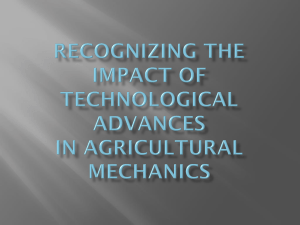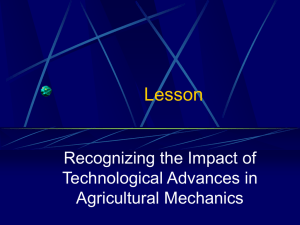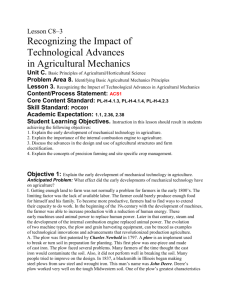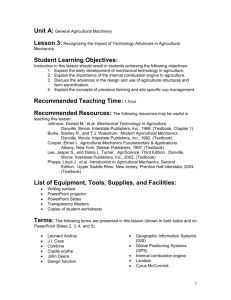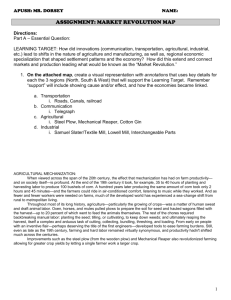UNIT C 8-3
advertisement
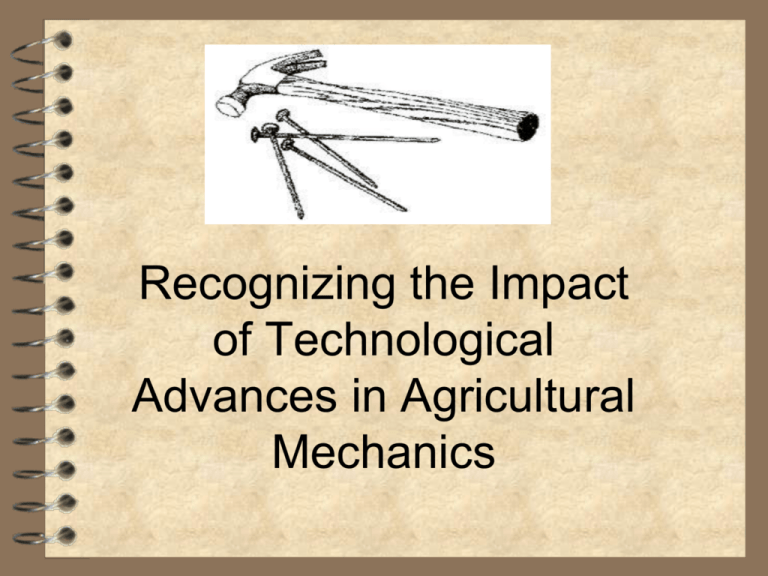
Recognizing the Impact of Technological Advances in Agricultural Mechanics Next Generation Scienc/Common Core Standards Addressed! HSSID.A.1 Represent data with plots on the real number line. (HS‐LS2‐6) CCSS.ELALiteracy.RST.9‐10.5 Analyze the structure of the relationships among concepts in a text, including relationships among key terms (e.g., force, friction, reaction force, energy) CCSS.ELALiteracy.RST.9‐10.8 Assess the extent to which the reasoning and evidence in a text support the author’s claim or a recommendation for solving a scientific or technical problem. Bell Work! Explain the early development of mechanical technology in agriculture. Explain the importance of the internal combustion engine to agriculture. Discuss the advances in the design of agriculture structures. Explain the concept of precision farming. Interest Approach “What are some major inventions of the past 200 years?” “Which are related to agriculture?” TERMS Combine Sickle Cradle scythe Technology Internal combustion engine GPS Landsat Scoured Plow reaper Objective: 1 What effect did the early developments of mechanical technology have on agriculture? Getting enough land to farm was not normally a problem for farmers in the early 1800’s. The limiting factor was the lack of available labor. The farmer could barely produce enough food for himself and his family. To become more productive, farmers had to find ways to extend their capacity to do work. In the beginning of the 19th century with the development of machines, the farmer was able to increase production with a reduction of human energy. These early machines used animal power to replace human power. Later in that century, steam and the development of the internal combustion engine replaced animal power. The evolution of two machine types, the plow and grain harvesting equipment, can be traced as examples of technological innovations and advancements that revolutionized production agriculture. Pictures from http://www.ytmag.com/ The Plow First patented by Charles Newbold in 1797. A plow is an implement used to break or turn soil in preparation for planting. This first plow was one-piece and made of cast iron. Pictures from http://www.ytmag.com/ The plow faced several problems. Many farmers of the time thought the cast iron would contaminate the soil. Also, it did not perform well in breaking the soil. Many people tried to improve on the design. In 1837, a blacksmith in Illinois began making steel plows from saw steel and wrought iron. This man’s name was John Deere. Deere’s plow worked very well on the tough Midwestern soil. Deere’s plow worked very well on the tough Midwestern soil. One of the plow’s greatest characteristics was that it scoured (self-cleaned) very well. Deere formed a partnership with Leonard Andrus and began producing his steel plows. Harvesting Equipment The technological advancements in equipment to harvest grain were much more dramatic than those in the development of the plow. Until the 1800s, the traditional tools for harvesting were the sickle and the cradle scythes. Harvesting Equipment The sickle is a sharp, curved metal blade fitted with a short handle. The cradle scythe is a hand-held implement with a long curved blade attached to a long, bent handle. The mechanical reaper was an implement that was used for cutting and gathering a crop. Harvesting Equipment The mechanical reaper was not developed until the 1830s. It was one of the most significant farming inventions of the 19th century. Harvesting Equipment The mechanical reaper was an implement that was used for cutting and gathering a crop. This machine reduced the amount of time and labor needed to harvest by more than one-half. Harvesting Equipment Cyrus McCormick patented the first horse-drawn reaper. Harvesting Equipment In the 1850s, J.I. Case began to manufacture and sell a “combine” – combination thresher-separatorwinrower – that threshed the grain, separated it from the straw, and removed that chaff. Harvesting Equipment Again, this machine greatly reduced the time and labor needed as well as crops lost during harvest. Steam Powered Tractors Early internal combustion engine tractors! Objective: 2 How has the internal combustion engine been important to agriculture? Internal Combustion Engine In the late 19th century, a tractor powered by an internal combustion engine was developed. An internal combustion engine converts the chemical energy from fuel into heat energy, which is converted into mechanical power. Internal Combustion Engine Tractors, trucks, and self-propelled machinery powered by the internal combustion engine revolutionized American agriculture. Internal Combustion Engine Almost all aspects of today’s agricultural production utilize the internal combustion engine in some way. Internal Combustion Engine The main reason for the success of the internal combustion engine was that it provided a reliable, efficient and mobile source of power. Objective: 3 What are some of the advances in the design and use of agricultural structures and farm electrification? Agriculture Structures Early farm structures were constructed for only one purpose. They were made to shelter livestock and equipment. The only building materials were those available locally. Agriculture Structures When designing a structure, the producer first determines what the design function of the building will be. A design function is the purpose for which a structure has been created. Agriculture Structures Internal environments can now be controlled. This gives the producer added control over the quality of the goods and products he/she sells. Electricity Although electricity has been a relatively recent addition to agriculture, the expansion of electrical technologies has been quite rapid. Objective: 4 What is precision farming and site specific crop management? Site Specific Crop Management (SSCM) The many advances in agricultural mechanics have allowed such operations to occur. There are many separate components that all work together to allow a producer to use SSCM Precision Farming Precision farming is using cropping practices that improve yield based on the needs of the land. Precision Farming As part of this system, fields are subdivided into small areas based on the information gathered by harvest results, soil testing, and satellite systems. Precision Farming This information is then used to determine the kinds and amount of inputs to be applied to the subdivisions of land. Precision Farming The goal of precision farming is to apply seed, fertilizer, and agricultural chemicals only where they are needed and only in the amounts needed. Remote Sensing Remote sensing involves gathering and recording data from a great distance. Most remote sensors are on satellites some 500 miles above the earth. Remote Sensing Landsat is the term used to describe the United States satellite system that makes photographs of the earth and plots the earth’s resources. These photos are used to make maps. Geographic Information Systems (GIS) Individual maps can be made for fertility, pesticide residues, soil type and texture, drainability and water holding capacity, and the previous year’s yield data. Geographic Information Systems (GIS) These maps are then used by the producer to make management decisions regarding application rates of fertilizers and other agricultural inputs. Geographic Information Systems (GIS) The satellite system used to gather this information is called the Global Positioning System (GPS). GPS was first developed as a defense system used by the US military forces. Variable Rate Technology (VRT) Using the information gathered with the Geographic Information Systems, the producer is able to vary the rate of application of all production inputs. This capability is called Variable Rate Technology. The End!
